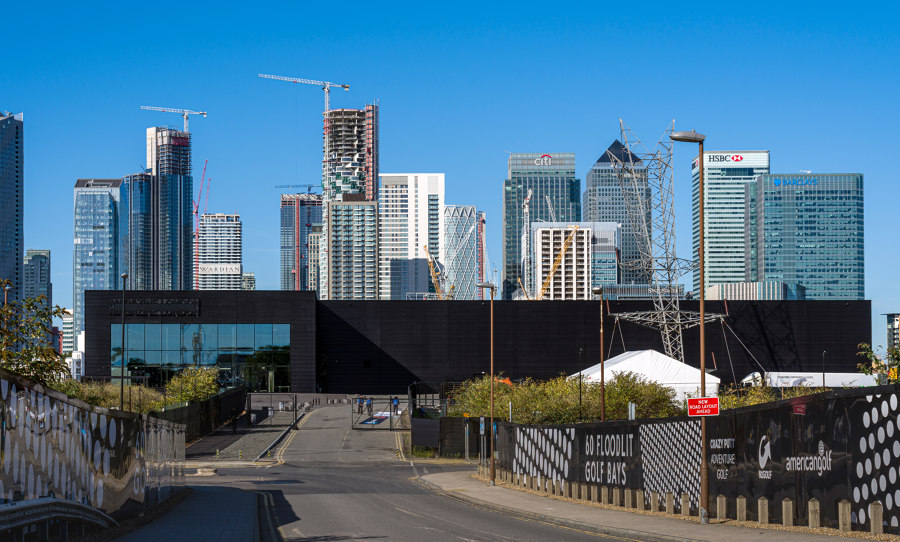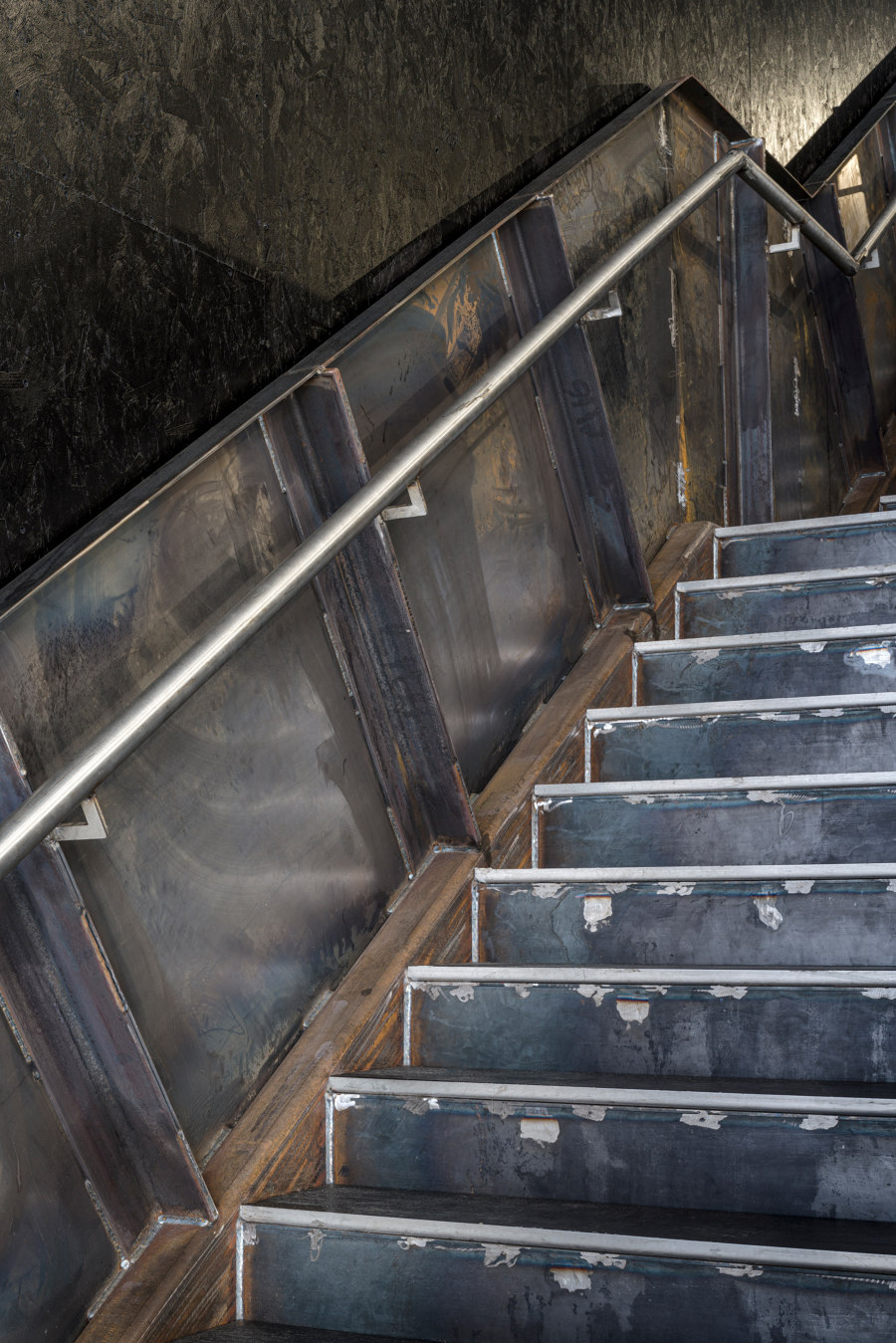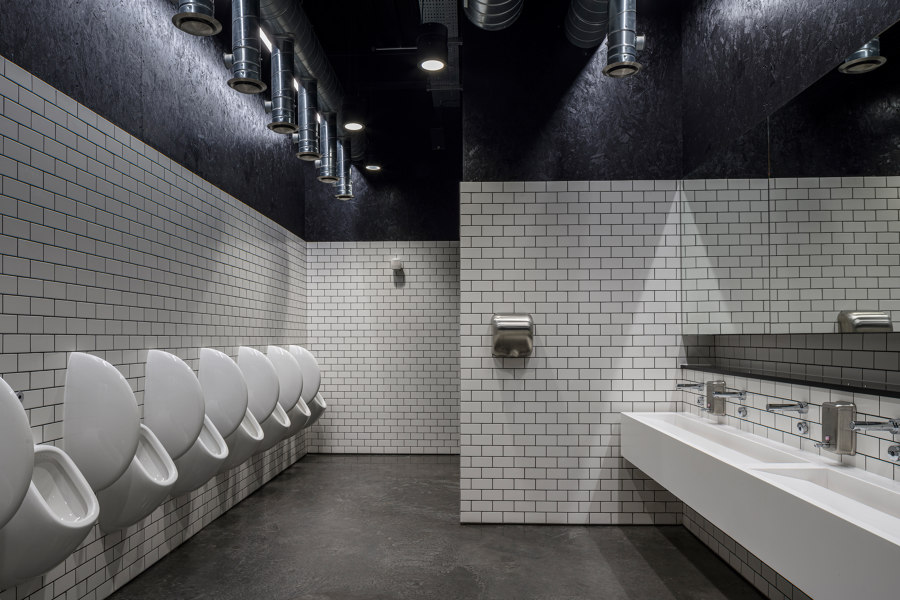Magazine London, a major new event space for the capital, has opened on the North Greenwich Peninsula. Designed by award-winning architects and cultural sector specialists Nissen Richards Studio, the building is an 8m-high, monolithic, L-shaped black box and a striking new neighbour for the O2’s white canopied structure to its right. As visitors approach from North Greenwich Station, Magazine London forms a dynamic new horizontal plane against the vertical cluster of Canary Wharf towers on the north bank of the Thames.
The purpose-built destination is now the largest of its kind in London, made up of over 3,200 sq m of versatile interior space, catering for up to 3,000 people and able to extend to accommodate a further 7,000 people by using the venue’s outdoor showground. The venue offers an entirely blank inner canvas for culture and commerce, enabling new forms of large-scale creative expression and embodying an unrivalled landscape for brand events, awards dinners, conferences, exhibitions, fashion, the arts and ticketed culture.
The project is a collaboration between innovative space creators Venue Lab, ticketed culture partner Broadwick Live, technical production specialists Vibration Design and Production, catering experts Moving Venue and property developers Knight Dragon. Situated on a brownfield site on the Thames riverbank to the west of the O2, the venue is designed for temporary use (up to 10-12 years), whilst the area undergoes extensive residential, commercial and cultural transformation. Access is also available to The Pylon, a site inspired by the famous Alex Chinneck installation, entitled ‘A Bullet from a Shooting Star’, which resembles an upside-down electricity pylon, as if the structure has been shot out of the sky and into the earth.
Magazine London is located on Ordnance Crescent and facing Ordnance Wharf and takes its name from the gunpowder magazine that used to sit close to the site.
“We sought to reference the site’s industrial heritage through a monolithic, warehouse-style architectural approach”, Nissen Richards Studio Director Jim Richards explained, “using a steel structure and saw-tooth external cladding, which creates further horizontal banding. The building’s steel frame is a unique design, in that instead of using a portal frame, the steelwork sub-contractor suggested a tapered steel column and a triple-pitched roof structure, which gives a rounded feel to the internal ridge line. The internal palette has been designed to be industrial, with very little that’s in any way superficial. Materials include patinated steel; black-painted OSB cladding; pressed and perforated black metal mesh cladding and a stand-out, exposed and polished concrete floor throughout – which also forms the concrete slab for the whole building.”
Although temporary, the building is strong and robust, with brutalist influences and a contemporary aesthetic and includes two raw steel cantilevered staircases, leading up to two mezzanine spaces. These form two of the four internal sections available for hire or separate usage. These also include Space 1, the entrance area or foyer, where full-height glazed walls at either end offer spectacular views through to the Thames and beyond, plus Space 2, the venue’s largest auditorium or event space.
Magazine London’s bold and striking branding is by Carter Studio, who worked closely with Nissen Richards Studio to help position the venue as a leading new space for contemporary culture. The doubling/repetition of the logo is redacted by a rectangular shape to create a frame for content, permitting a variety of digital and print applications. The main site signage above the entrance is backlit at night with the brand name in black, helping make the building a glowing and iconic new local landmark.
For Nissen Richards Studio, a practice that combines architecture with an experimental, theatre-based sensibility and whose exhibition design projects can be seen everywhere from Sutton Hoo, Kensington Palace, the Natural History Museum, the Wallace Collection and the British Museum to key cultural locations in Norway, Holland, China and the Middle East, this project is a notable addition to a growing cultural venue portfolio. It also marks the third occasion the practice has collaborated with Vibration Group, including previous projects Exhibition London and Printworks London, where a new live music space was created within the former press hall that previously delivered the Metro and Evening Standard newspapers. Nissen Richards Studio is also working currently on the transformation of Clwb Ifor Bach, an iconic music venue in Cardiff.
Visitors arrive at Magazine London from a dipping approach road from North Greenwich underground station, creating a great first reveal of the building against the Thames as the road climbs back up. Visitors enter the building directly into the foyer space (Space 1), where floor-to-ceiling glazing provides views right through to the full-height glazed back wall and the river beyond. The elegant, glazed curtain walls have been designed in regular modules, with slim-profile glazing mullions for minimum visual disruption. The dimensions of Space 1 are 35m(l) × 25m(w) × 8m(h), giving an overall volume of 875 sq m, with a maximum capacity of 1,750 people. External landscaping beyond and to the left of this space includes The Deck and The Yard, black-tiled terrace areas, and the showground beyond. Anti-terrorist barriers at the main entrance take the form of hexagonal concrete bollards, an inspired re-use of materials from an earlier project.
With an 8m-high ceiling, the light-filled entry space also creates an immediate sense of scale. To the right, two cantilevered staircases lead both left and right to mezzanines 1 and 2 (offering 300 and 280 sq m of space respectively), which can be used as bars, VIP areas or overflow for higher guest numbers or otherwise as break-out, seminar and exhibition spaces. The stairs have a raw steel outer balustrade and feature black timber treads and stainless steel handrails.
Directly below the mezzanines are the toilet block and two dividing gates, enabling the larger spaces to be opened and closed for separate concurrent events, or else to seal off ongoing preparation for an event, particularly in the larger, fully-enclosed auditorium space, which also has its own dedicated rear access for stage-builders or event teams.
The main space (Space 2), through the double-gated central passage, is the largest internal space at Magazine London. Here, the vast walls are also stained black, creating a striking backdrop for event producers to stage brand introductions or dynamic events. The space also features an 8m-high ceiling with added lighting rigs and exposed services, including service runs, fresh air ducts and cable trays, as well as polished black concrete floors. Its internal steel structure features innovative, angled columns that come down almost to a point at ground level, helping create more space, as well as reducing manufacturing costs.
The space also features removable staging infrastructure, an effectively-invisible sound box built into the archway entrance area and direct vehicle access for automotive launches and displays. A back-of-house area includes a plant room and a bespoke kitchen for large-scale catering. Space 2 is ideal for conferences, award ceremonies, dinners, exhibitions and brand events, with dimensions of 50m(l) × 35m(w) × 8m(h) and a volume of 1,750 sq m, with a capacity of 3,000.
Jim Richards, Director of Nissen Richards Studio commented “It’s very exciting for us to build upon our existing relationship with Vibration Group to devise and create this new dynamic event space for London. We’ve also immensely enjoyed working with Knight Dragon and the wider project team in the delivery of this project”.
Knight Dragon Ltd CEO Richard Margree said: “Magazine London fits superbly with what we’re doing on Greenwich Peninsula - creating a new London underpinned by creativity, a community with culture and entertainment at its heart. As well as the hugely successful O2 and the Design District opening in 2020, Magazine London adds another dimension, and another destination, to the emerging Peninsula.”
Vibration Group Strategy & Creative Director, Simeon Aldred added: “As London’s most exciting and innovative new events venue, the design of Magazine London played an integral part in the overall concept of what we wanted to deliver to the capital’s landscape. The striking black, warehouse-style canvas provides a stunning backdrop for all of our client’s needs, allowing flexibility against the unique landscape of the venue. Working alongside Nissen Richards Studio allowed our vision to come to life in creating a truly one a kind events space.”
“Magazine London is set to become an integral part of the capital’s events landscape. We are thrilled to have now launched the venue, with an amazing calibre of events lined up towards 2020 and onwards. This is a huge milestone for the development of Greenwich Peninsula, and to have created a brand-new cultural venue here is crucial in adding to the cultural diversity of the area.”
Design Team:
Nissen Richards Studio
Quantity Surveyor and Employer’s Agent: Artelia Group
CDM Principal Designer: Stace
Structural Engineer (Pre-Novation): Aecom
M&E Engineer (Pre-Novation): Aecom
'Magazine’ Branding: Carter Studio
Main Contractor: Losberger DeBoer
Structural Steel and Cladding Subcontractor: Astron
M&E and Services Subcontractor: Acclimatise
Slab and Groundworks Subcontractor: Maxeva
Fit-Out Subcontractor: WM Events
Signage Fabrication Subcontractor: Cherwell Signs
Curtain Walling Subcontractor: Imperial Facades
Steel Doors Subcontractor: Ascot Doors
Washrooms Subcontractor: Washrooms Ltd
Steelwork and Staircases Subcontractor: Total Steelwork & Fabrication Ltd
Platform Lift Subcontractor: Sheridan Lifts Ltd
Joint Clients: Knight Dragon Developments Limited; Venue Lab (Part of Vibration Group)





































